SEEING WHAT’S INVISIBLE
In describing Invisible Cities, allow me to paraphrase Gore Vidal’s critique of Italo Calvino’s 1972 novel of the same name on which this production is based: Of all tasks in reviewing director Yuval Sharon’s marvelously inventive theater event in Union Station, recounting Christopher Cerrone’s opera is the most difficult and perfectly irrelevant. The opera itself, while being far more pleasing and far less irritating than The Industry’s Crescent City: A Hyperopera, Invisible Cities in this context is inconsequential as a score.
The happening itself, however, is far from irrelevant or inconsequential. Regardless of the material, this joint production from The Industry and L.A. Dance Project is a fascinating display of unbounded creativity and talent – and a helluva lot of fun. As theater practitioners continue to experiment with site-specific theater (that which occurs in a space conducive to the script) and immersive theater (productions developed for a manufactured environment), a shapeshifting landscape is emerging which I call interactive theater, in which spectators take on a participatory role. It’s a murky territory difficult to categorize: When Odet’s Waiting for Lefty has cab drivers speak from the audience or Brecht’s Epic theatre has actors speak directly to us in a proscenium house or the groundlings answer back to Elizabethan players, is that not all interactive theater on some level?
The difference now is the domineering presence of the internet. As live performances compete with technology which entertains from the palm of your hand, consumers are attracted and swayed by entertainments where they are less likely to be passive observers. And producers know this. Only recently, I saw Gallery Secrets, four new playlets done inside the Natural History Museum after closing; The Importance of Being Earnest inside the L. A. Athletic Club; Macbeth in a Civil War-era fort underneath the Golden Gate Bridge; and an outdoors Our Town as part of La Jolla Playhouse’s Without Walls Festival. Whether scrambling up a spiral staircase or following actors around a Gem Exhibit or being videotaped and projected onto a large screen, being part of the action is an undeniable thrill.
And Union Station is one of the most perfect locations for interactive theater I have ever seen. One of the show’s stars is the 1939 transit hub, designed by John Parkinson and Donald B. Parkinson (who also designed L.A.’s City Hall), which combines Dutch Colonial Revival architecture, Mission Revival, and Streamline Moderne style. The detailed nooks and crannies one would normally miss running for a train, such as the tile-work, become vivid as we linger.
So, along with about 200 other patrons, I donned state-of-the-art headphones and followed singers and dancers as they performed throughout Union Station among the throng of bemused train customers who observed the proceedings as well (many, no doubt, believed this was some kind of flash mob).
We were informed from the start that this would be OUR experience and we were free to roam about at will. The inside of the program offers optional activities such as “Dance,” “Imagine our future city,” “Buy a drink at the bar,” “Study the tiles” and “Picture Kublai Khan.”
Along with Marco Polo, Kublai Khan is the main character of Calvino’s fictional novel, which is more or less a conversation between the two even though they do not speak the same language. Khan is concerned about his empire’s decline and hopes that Polo’s vivid descriptions of cities (real and imagined) will offer hope for a brighter tomorrow. There is little dialogue and the book consists of mostly prose poems describing 55 cities.
Cerrone’s libretto for his 7-scene opera, liberally lifted from Calvino’s text (translated by William Weaver), describes but a few. The score is almost Wagnerian in the way that it builds and then pulls back. Overall, it’s meditative and pleasant, sometimes eerie like a science fiction thriller, and exquisitely orchestrated for 11 players under the tight leadership of Marc Lowenstein (the show begins with all of us gathered in a side room for the thrilling overture).
But since the musical lines are atonal (read: no discernible melody), the lyrics refused to penetrate my brain. It wasn’t until halfway through that I noticed them displayed above our heads (fluid and sharp projection design by Jason H. Thompson). Glimpsing up at the words (“You hear them singing” and “I speak and speak, but the listener retains only what he is expecting”) proved too taxing and actually served to interrupt my reverie; it’s no accident that the program suggests another activity: “Visualize Marco Polo trying to communicate to him.” The entire work is so ethereal that my theatergoing companion continued to wear his headphones not knowing that the opera had concluded.
Aside from the tale’s allusion to travel and a hint of Moroccan features at Union Station, this is hardly a site-specific affair. Truth be told, had Mr. Cerrone’s opera been replaced by Philip Glass music or the greatest hits of Walt Disney, the experience would have been no less captivating and enjoyable.
The bottom line is that you don’t need to know what’s going on to have a blast. Think Cirque du Soleil here. Their press kits are pages thick with exposition, explaining the story behind their shows and music. Yet I defy anyone to remember anything but a series of great acts. It’s the same with Invisible Cities: Who cares what the story is about when eight amazingly nimble dancers execute Danielle Agami’s angular/spasmodic/sinewy choreography on the floor and on top of the ticket counters? If L.A. Dance Project continues work like this, our metropolis may one day be known as The City of Ankles. The dancers are Charlie Allan Hodges, Anthony Bryant, Aaron Carr, Julia Marion Eichten, Morgan Taylor Lugo, Nathan B. Makolandra, Rachelle Ann Rafailedes and Amanda Kramer Wells.
You may be disoriented at first, but there are plenty of actors to follow; you could end up anywhere from the enclosed garden patios to the gloriously refurbished ticket room, normally off-limits to patrons. There’s Marco Polo, a large black man with a backpack singing at TRAXX Restaurant (the pure-voiced tenor Ashley Faatoalia); a Khan in a wheelchair and later clothed in 13th century garb (resonant bass-baritone Cedric Berry from Crescent City); two robed silver-throated soprano nursemaids from somewhere in antiquity (Delaram Kamareh and Ashley Knight); four singers who play everything from janitors to masked Venetians (soprano Maria Elena Altany, alto Sarah Beaty, tenor Stephen Anastasia, bass Cale Olson); and those dancers in outfits streaked with white paint (imaginative costumes by E.B. Brooks).
My favorite moment occurred when I followed a woman in a pink down jacket and black fuzzy slippers with a plastic shopping bag among the dancers. How fascinating, I thought. This added element of homelessness is perfect for Invisible Cities. But then the woman disappeared out the front doors to inspect the garbage. For me, that moment represented Sharon’s intention more than any other. The mastermind behind all of this wants us to examine our city and imagine a better world for all.
But there is something I examined which unsettled me: As if some kind of documentary crew taping the performance art wasn’t intrusive enough, many many patrons had their cell phones out and were doing the same thing (a few, with headphones around their neck, were actually texting). For all the wonderment around us, I believe patrons utilized electronica because they were not emotionally engaged.
This is one of the most buzzed-about openings of the year (the creators were even given proclamations by the city of L. A. after opening night), there is a lot of money behind it, and the logistics involved are mind-boggling. Even with five additional dates added, the run sold out just after opening (keep checking for tickets). As breathtaking as this shebang is, I can’t help hoping that all of this interactive theater will one day offer a story that we can sink our teeth into and touches our heart. In the meantime, a cerebral blow job is nothing to scoff at.
photos by Dana Ross
Invisible Cities
The Industry and L.A. Dance Project
Union Station, 800 N. Alameda Ave
scheduled to end on November 8, 2013
for tickets, call 866-811-4111 or visit http://invisiblecitiesopera.com/
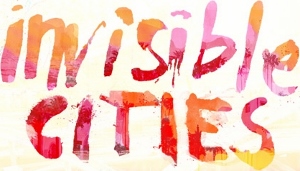
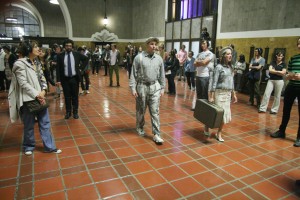
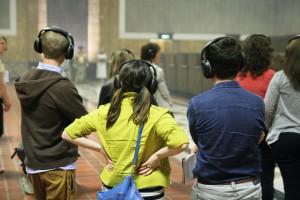
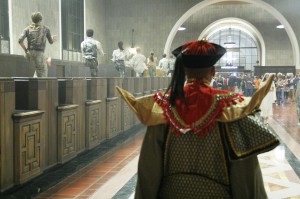
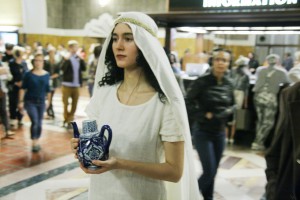
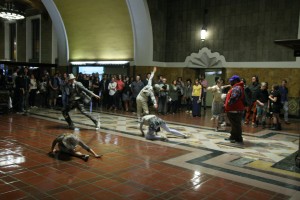
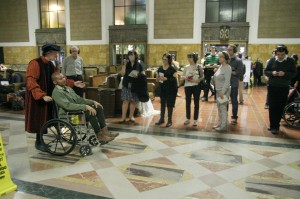
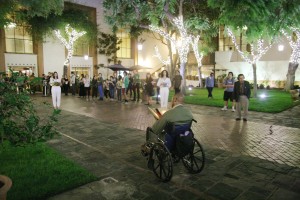
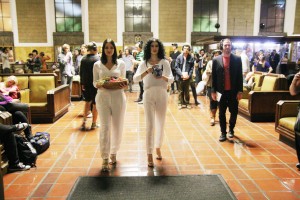
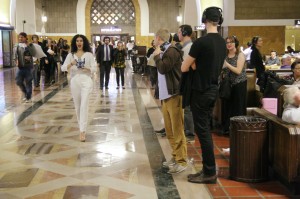

{ 1 comment… read it below or add one }
“a cerebral blow job” sounds like something I would enjoy. Got my tickets for extended run since I missed the invited dress. Looking forward to the creative copulation of music, voice, dance and the “woman in a pink down jacket with black fuzzy slippers.”